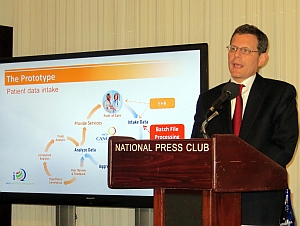American Society of Clinical Oncology (ASCO) in Alexandria, Virginia demonstrated a prototype of its CancerLinq system based on information in patient records that aims to provide clinicians with better tools for decision-making. ASCO demonstrated the system yesterday at the National Press Club in Washington, D.C.
The goal of CancerLinq is to provide cancer physicians and nurses with guidance based on actual clinical experiences easily accessible at the point of care. The only data now readily available for this purpose, says Sandra Swain, medical director of the Washington Cancer Institute at Medstar Hospital Center in Washington, D.C., come from clinical trials, which represent only about three percent of cancer patients. “We’re losing the other 97 percent,” which CancerLinq plans to capture, says Swain, who is also ASCO’s current president.
Collecting the data from patient records, however, is a difficult task because of the many incompatible native formats in the systems storing the data. ASCO says it takes advantage of advances in natural language processing, data storage, and computer power to overcome these format differences. The system also has data mining and display tools, and incorporates ASCO’s clinical practice and quality guidelines to generate recommendations on patient care that can tap into the accumulated experience from the records.
The CancerLinq prototype has some 100,000 records from breast cancer patients, with identifying data removed, contributed by hospitals in the U.S. Clifford Hudis, chief of breast cancer medicine at Memorial Sloan Kettering Cancer Center in New York, gave the demonstration using the record of a typical breast cancer patient’s diagnosis and treatment as an example. Hudis is ASCO’s president-elect.
The demonstration illustated the use of open-source tools in CancerLinq. While CancerLinq collects data from a number of incompatible formats, its database uses the open-source OpenMRS medical informatics format. The system also uses open-source analytical tools, said Hudis, who showed CancerLinq’s correlation and trend analysis capabilities. The graphic display features, however, use the commercial Galileo Cosmos analytics package. The demo showed as well the system providing clinical recommendations and feedback based on ASCO’s quality guidelines.
Swain told Science Business that ASCO raised some $100 million to develop CancerLinq, but the use of open source software helped keep the cost of building the system under budget. The funds for developing CancerLinq, said Swain, came from corporate and foundation donations.
Hudis said CancerLinq is in the “proof of principle stage”, with still more development work required, which includes expanding the system to cover other forms of cancer. Nonetheless, according to Charles Penley, a practicing oncologist from Nashville and a panelist at the news conference, said the system “makes it possible to query the collective experience of cancer physicians sharing the system.” Penley’s practice, Tennessee Oncology, contributed some 12,000 records to CancerLinq.
Read more:
- Consortium to Develop Disease Model for Multiple Sclerosis
- Grant to Fund Patient-Sourced Health Outcome Measures
- Weill Cornell, N.Y. Hospital Open Precision Medicine Center
- University, Companies to Build Medical Analytics Platform
- Analytics Company, Johns Hopkins to Study Asthma Genomes
* * *


 RSS - Posts
RSS - Posts
You must be logged in to post a comment.